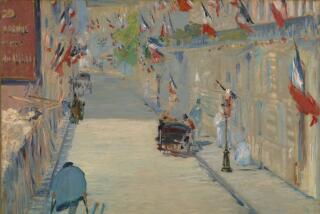La Cienega Area
- Share via
Quick, what do Southern California artist John Baldessari and 18th-Century English clergyman Laurence Sterne have in common? A similar sense of absurdity, it would seem. Baldessari’s trademark manipulations of “found” black-and-white photographs slyly worm their way into the text of Sterne’s “The Life and Opinions of Tristram Shandy, Gentleman” in a new edition (of 400 three-volume sets) published by Arion Press in San Francisco.
The rambling account of an eccentric family, considered a seminal English novel, it is written in a style studded with free associations ripe for the plucking. A photograph shows two nude women with big colored dots plastered over their faces romping on a huge rock that looks like a nose (thanks to Baldessari’s judicious outlining in red). The text reads: “ ‘Tut! tut!’ said the stranger. ‘I have been at the promontory of noses and have got me one of the goodliest and jolliest.’ ”
Elsewhere, the artist’s visual treatment incorporates not only elements of a particular phrase but echoes of ideas found elsewhere on the page; no doubt a closer reading would stumble upon other, more devious foolery.
Clegg and Guttmann are a young pair of German artists living in New York who do cynical updates on traditional painting genres (landscape, still life and portraiture) in large-format Cibachrome photographs. Their pieces-de-resistance are formal portraits of unsmiling wealthy people seen against corporate or blue-chip art-gallery backgrounds. At Merrill Lynch, the red walls gleam with bloody intensity; at Sidney Janis Gallery, a small army of Giacometti sculptures casts huge shadows and a cluster of frames appear to contain no visible paintings.
“The Art Foundation”--with soberly attired sitters (one is Henry Hopkins, director of the Frederick Weisman Collection) whose carefully posed hands form a graceful pattern--is somewhat reminiscent of Franz Hals’ “The Women Regents of the Old Men’s Home at Haarlem” of 1664, but with a latter-day hollowness replacing the old women’s otherworldly severity.
In their book of still lifes, Clegg and Guttmann ring a few changes on 17th-Century memento mori. A lifesize image of periodical index shelves stocked with the flimsy blue Readers’ Guide supplements and fat volumes dating back to the 1930s and ‘50s has a rather pathetic air in this increasingly specialized and computerized age. (Margo Leavin Gallery, 812 N. Robertson Blvd., to Dec. 23.)
More to Read
The biggest entertainment stories
Get our big stories about Hollywood, film, television, music, arts, culture and more right in your inbox as soon as they publish.
You may occasionally receive promotional content from the Los Angeles Times.










